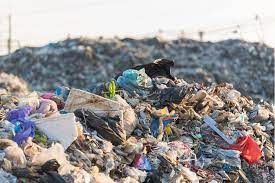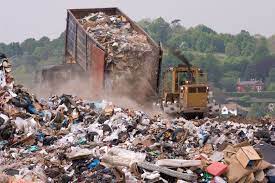Landfills are designated areas where waste materials are disposed of and buried in the ground. They are commonly used for the disposal of non-hazardous solid waste generated by households, businesses, and industries. Landfills are designed to provide a controlled environment for waste disposal and to minimize any potential harm to human health and the environment.
Landfills play a significant role in waste management, but their impact on the environment has raised concerns over the years. In addition to exploring whether landfills decompose, this article aims to shed light on the disadvantages of non-renewable resources and the effects of drilling for oil on the environment.
When it comes to the decomposition of waste in landfills, the process is not as straightforward as one might expect. Due to the way landfills are designed and managed, decomposition is significantly slowed down. Traditional landfills are designed to limit the contact between waste and oxygen, resulting in anaerobic conditions that impede decomposition. As a result, the breakdown of organic materials takes a much longer time, often spanning decades or even centuries.
Furthermore, the types of materials present in landfills also impact the decomposition process. Non-biodegradable materials, such as plastics, do not break down easily and can persist in landfills for hundreds of years. These materials contribute to the growing issue of plastic pollution and pose significant challenges for waste management.
Disadvantages of Non-Renewable Resources
Non-renewable resources, including fossil fuels like oil, natural gas, and coal, have been extensively exploited to meet energy demands worldwide. However, their use comes with several disadvantages, primarily related to their limited availability and the environmental consequences associated with their extraction and consumption.
1. Limited Availability
Non-renewable resources are finite and cannot be replenished within a human lifetime. As these resources are being depleted, their scarcity increases, leading to higher costs and potential geopolitical conflicts over control and access.
2. Environmental Impact
Extracting and burning non-renewable resources contribute to air and water pollution, greenhouse gas emissions, and climate change. The drilling for oil, in particular, poses significant environmental risks, including oil spills, habitat destruction, and contamination of ecosystems. These consequences not only harm wildlife but also affect human health and wellbeing.
Management of Pericardial Effusion
While pericardial effusion, the buildup of fluid in the pericardial sac surrounding the heart, may seem unrelated to landfills and non-renewable resources, it highlights the importance of effective waste management.
The disposal of hazardous materials, such as certain chemicals and pharmaceuticals, can lead to contamination of soil and water sources, potentially affecting human health. Proper waste management practices, including safe disposal methods and recycling, are essential in preventing such pollution.
Do Landfills Decompose?

Landfills do decompose, but the process is significantly slowed down due to the design and management practices employed. Non-renewable resources, on the other hand, come with their own set of disadvantages, including limited availability and adverse environmental impacts. Drilling for oil, in particular, has detrimental effects on the environment, including habitat destruction and oil spills.
By understanding these issues, we can promote sustainable waste management practices, reduce our dependence on non-renewable resources, and work towards a cleaner and healthier future for our planet.
Effects of Drilling for Oil on the Environment
The process of drilling for oil, both on land and offshore, has significant environmental implications. Let’s delve deeper into the specific effects:
1. Habitat Destruction
Oil drilling often requires the clearing of land or the creation of offshore platforms, leading to the destruction of natural habitats. This disruption can have severe consequences for local ecosystems and wildlife, displacing species and causing a loss of biodiversity.
Fragile marine environments, such as coral reefs and coastal wetlands, are particularly vulnerable to the damaging effects of oil drilling.
2. Oil Spills
Accidental oil spills during drilling, transportation, or storage can have catastrophic consequences. When oil is released into the environment, it spreads rapidly and can contaminate water bodies, shorelines, and surrounding ecosystems.
These spills can devastate marine life, disrupt food chains, and cause long-term ecological damage. The Deepwater Horizon oil spill in 2010, for example, had far-reaching impacts on the Gulf of Mexico’s ecosystem and local communities.
Read Also: Inhaler Disposal Dilemma and Sustainable Solutions
3. Water Pollution
Drilling operations often require large quantities of water for drilling fluids and equipment cooling. Improper handling and disposal of these fluids can lead to water pollution.
The fluids can contain harmful chemicals and heavy metals that can contaminate groundwater sources, affecting both human and animal populations that rely on them.
Additionally, wastewater generated during drilling, known as produced water, can contain pollutants and toxins that require careful treatment before disposal.
4. Air Pollution
The extraction and combustion of oil produce various air pollutants, including sulfur dioxide, nitrogen oxides, and volatile organic compounds. These pollutants contribute to smog formation, acid rain, and respiratory problems.
Furthermore, drilling activities release methane, a potent greenhouse gas that significantly contributes to global warming. Methane emissions during oil extraction and transportation exacerbate climate change and its associated environmental consequences.
5. Climate Change Impact
The burning of fossil fuels, including oil, is a major contributor to greenhouse gas emissions. These emissions trap heat in the atmosphere, leading to global warming and climate change.
The extraction and combustion of oil significantly contribute to the rise in carbon dioxide levels, exacerbating the Earth’s changing climate patterns and posing risks to ecosystems, agriculture, and human livelihoods.
To mitigate the environmental impact of oil drilling and reduce our reliance on non-renewable resources, various measures can be taken:
1. Transition to Renewable Energy
Investing in renewable energy sources, such as solar, wind, and hydropower, reduces the need for oil and other fossil fuels. Governments, businesses, and individuals can support the development and adoption of clean energy technologies to move towards a more sustainable energy future.
2. Strict Regulations and Monitoring
Governments and regulatory bodies should enforce stringent regulations and monitoring practices to ensure that drilling activities adhere to environmental standards. This includes measures to prevent oil spills, enforce proper disposal of drilling waste, and limit air and water pollution.
3. Promote Energy Efficiency
Encouraging energy-efficient practices and technologies can help reduce overall energy consumption and, consequently, the demand for oil. This includes initiatives such as energy-efficient building designs, fuel-efficient transportation systems, and the use of energy-saving appliances.
4. Research and Development
Continued research into alternative energy sources, advanced drilling technologies, and environmentally friendly practices can lead to innovations that minimize the negative impact of oil drilling on the environment.
The effects of drilling for oil on the environment are significant and far-reaching. Habitat destruction, oil spills, water and air pollution, and climate change impacts all underscore the urgent need to transition to sustainable and renewable energy sources.
By adopting cleaner and more responsible practices, we can minimize the environmental harm caused by non-renewable resources and work towards a greener and more resilient planet.
Read Also: Confronting the Menace of Plastic Waste Pollution
In light of the environmental challenges associated with landfills and non-renewable resources, effective waste management practices become crucial. By implementing sustainable waste management strategies, we can mitigate the negative impact on the environment. Here are some key aspects of waste management that deserve attention:
1. Reduce, Reuse, and Recycle
The concept of the “3 Rs” (reduce, reuse, recycle) forms the foundation of sustainable waste management. By reducing the amount of waste generated, promoting the reuse of products and materials, and maximizing recycling efforts, we can minimize the volume of waste ending up in landfills. Recycling plays a vital role in diverting materials from disposal sites, conserving resources, and reducing energy consumption.
2. Composting
Organic waste, such as food scraps and yard trimmings, can be diverted from landfills and transformed into nutrient-rich compost through proper composting practices. Composting not only reduces the amount of waste sent to landfills but also provides a valuable resource for improving soil health and promoting sustainable agriculture.
3. Waste-to-Energy Conversion
Advanced waste management technologies, such as waste-to-energy conversion, offer alternatives to traditional landfill disposal. Processes like incineration and anaerobic digestion can help generate energy from waste materials, reducing reliance on non-renewable resources and minimizing the volume of waste that would otherwise end up in landfills.
4. Hazardous Waste Disposal
Proper management of hazardous waste, including chemicals, pharmaceuticals, and electronic waste, is essential to prevent contamination of soil, water, and air. Implementing safe disposal methods, establishing collection programs, and promoting responsible recycling of hazardous materials can help mitigate the adverse effects on the environment and human health.
5. Landfill Management and Remediation
Existing landfills need to be carefully managed to minimize their environmental impact. This includes proper engineering and design of landfills to prevent leachate and methane gas leakage, as well as the implementation of monitoring systems to ensure compliance with environmental regulations. Additionally, the remediation of abandoned or poorly managed landfills can help mitigate pollution risks and restore affected areas.
Landfills do decompose, albeit at a much slower rate due to the anaerobic conditions and the presence of non-biodegradable materials. However, the environmental impact associated with landfills, non-renewable resources, and drilling for oil necessitates a shift towards sustainable waste management practices and renewable energy sources.
By embracing the principles of reduce, reuse, and recycle, promoting composting and waste-to-energy conversion, and effectively managing hazardous waste, we can minimize the harm caused to the environment. It is through these collective efforts that we can pave the way for a greener and more sustainable future.
Read Also: The Rise of Startup Marketing Companies

